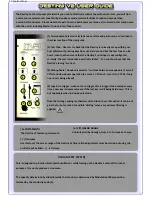
7 Programming -Oscillators
3
( OSC SYNC CONTINUED )
The important characteristic of oscillator synchronising is that
changing oscillator 2’s pitch will change the
timbre of the oscillator section but the pitch of both oscillators
will track the pitch setting for oscillator 1.
By modulating the 2nd oscillator’s pitch using the Destiny v2’s
envelopes or LFOs, sync’ing will provide another
means to have your patch’s timbre evolve as a key continues to
be held down (along side with filter modulation -
described later in the user guide).
OSCILLATOR ONE KEY-TRACK ON/OFF (3)
There are several factors which determine the pitch of the
Destiny v2’s oscillators, besides their specific tuning
settings; other factors include; master-octave control , pitch-
bend midi data, modulation sources and of course
the keyboard itself.
Oscillator Two is ‘hard wired’ to the keyboard and tracks it with
a standard piano scale.
Oscillator One can have key-track turned on or off, using the
switch (3).
When key-tracking is turned off, oscillator One’s pitch is
controlled by the frequency sliders and pitch modulation
sources.
WAVEFORMS
Each of the Destiny’s two oscillators can output 2 different wave forms
-
sawtooth
&
pulse
.
There are no switches to switch between the two waves; The oscillators output both simultaneously and
they can subsequently be routed as to your requirements in other sections of the synth.
OSCILLATOR MODULATION
Two aspects of oscillator function can be modulated
(constantly varied) from other parts of the instrument.
They are 1) Pitch
2) Pulse width.
The latter is discussed in the next section.
Pitch modulation works as follows:
4
Like the main oscillators, the Destiny’s
LFO
outputs two
waves simulaniously. Use switch (4) to switch between them
when applying LFO->pitch modulation to oscillator One. Set
the amount using slider (5). The LFO is discussed in detail
later on, so don’t worry if you’re not familiar with it right
now.
Sample & Hold (S/H) and Envelopes (ADSR) are also discussed later on. For now, suffice to say they can
both be a modulation source; use switch (6) to select between them and adjust the amount using slider (7).
Oscillator Two has similar controls, but please note that switch (8) can select between an LFO sine wave
and input from the S/H
MIXER
. More on that later.
5
7
6
8
FM stands for ‘Frequency
Modulation’!























